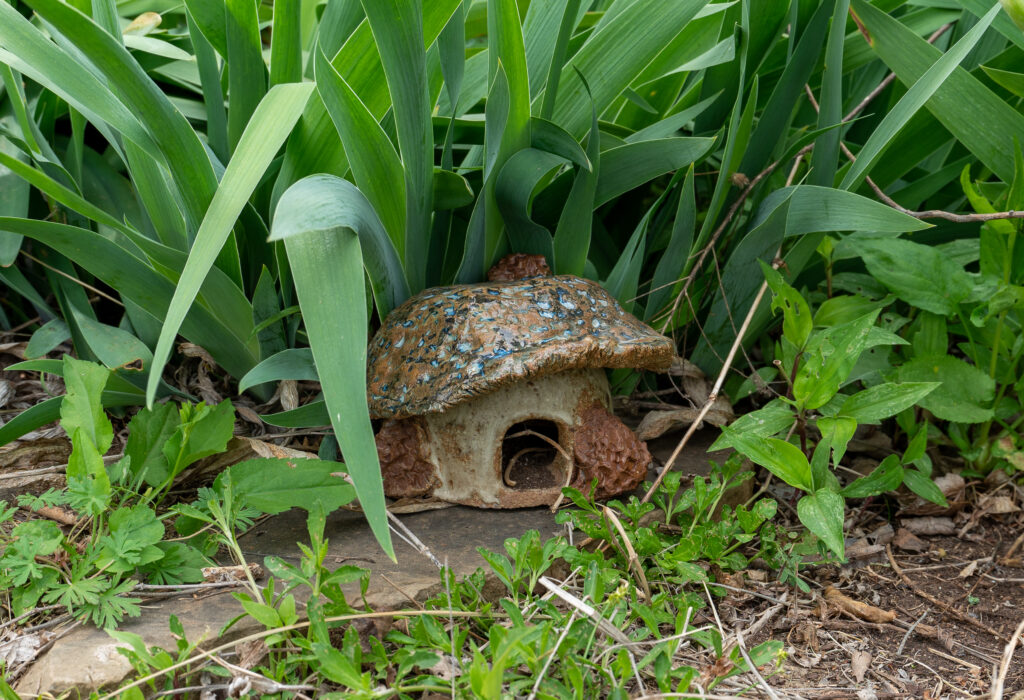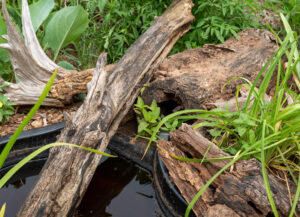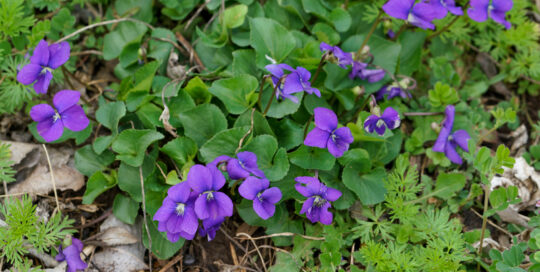Last spring, a strong thunderstorm knocked down the cottonwood in our front yard. It left a gaping hole in the middle of a flowerbed that I didn’t have the energy to fill. I was so despondent by the destruction that I didn’t do anything with that flowerbed for the rest of the year. A month or so ago, a friend suggested turning it into a small bog or water feature. I liked that idea very much; water features are an easy way to create microclimates and microhabitats to benefit wildlife.
A friend (thanks, Deb!) helped me find and install a small pre-formed pond liner. I added a hollow log, blue mistflower (Conoclinium coelestinum) for the overflow area, a log for easy access to (or escape from) the pond, a few other plants, and, voila! An instant addition to my garden that’s a perfect shelter for frogs, toads, lizards, or whatever small animal decides to claim it. (I’m hoping for frogs or toads.) The water and overflow area is a microclimate supporting the native mistflower, which likes wet meadows and ditches and is a popular flower with pollinators, and the pond and hollow log create a mini microhabitat for some lucky animal in need of shelter and access to water.
What are Microclimates?
Microclimates are small areas within a larger space that offer different environmental conditions compared to the surrounding area. These can include variations in temperature, moisture, light, and wind protection. By manipulating these elements, gardeners can create spaces that cater specifically to the needs of certain wildlife species.
Crafting Microclimates
To start, observe how sunlight and shade play across your garden throughout the day and across seasons. Areas that receive morning sun but are shaded in the afternoon are cooler, making them ideal for species that prefer less intense heat. Conversely, spots that bask in full sun can host sun-loving plants that attract a myriad of insects and provide warm basking spots for reptiles.
In colder zones, flowerbeds on the south side of buildings may stay sheltered and warmer in winter – up to a full zone warmer, in some cases – providing an opportunity to plant species that might not survive other areas in the yard. Differences in soils may allow you to plant a rock garden in one area while supporting more traditional beds in others.
Planting a variety of trees and shrubs can drastically alter the microclimate of a garden. For instance, a dense shrub can provide necessary shade and coolness, creating a damp, sheltered area ideal for toads. Adding a water feature like a small pond can also attract insects for the toads to feed on.
Creating Microhabitats
Microhabitats, on the other hand, are specific environments that support different types of wildlife. These can range from a log pile that offers a hiding spot and a hunting ground for insects, to dense undergrowth that provides shelter and nesting sites for small mammals. Microhabitats often go hand in hand with microclimates. For example, your dry, sandy rock garden is likely to attract different species than your water garden.
For Toads:
Creating a toad habitat can be as simple as leaving a part of your garden a little wild. Allow leaf litter to accumulate and logs to decay. Toads and other amphibians are particularly susceptible to dehydration, so ensuring they have a shady, damp place to retreat during the heat of the day is crucial. Installing a small toad house, made from a buried pot or a woodpile, can provide a much-needed sanctuary.

A small toad house.
For Insects:
Insects are incredibly diverse, and their needs are just as varied. Flowering plants are obvious choices for attracting pollinators but don’t forget about the less glamorous insects. Leaf litter, dead wood, and even bare soil are excellent for beetles, spiders, and other ground-nesting insects.
For Mammals:
Mammals such as small rodents and even bats benefit from diverse garden habitats. A pile of leaves or wood can offer refuge for small mammals. For bats, retaining old trees or installing a bat box can provide roosting spots. Using rocks to create small caves or shelters can provide shelter for many types of animals.
For Birds:
Birds require a mixture of feeding, nesting, and protective sites. Plant native trees or shrubs with dense foliage to offer shelter and nesting spots. Feeders and baths attract birds and give them a reason to stay in your garden, while varied plant heights create a layered canopy that simulates a natural environment.
The Bigger Picture
By integrating a variety of plant species and structural elements, such as logs, stones, and water features, you create a complex environment that can support a wide range of organisms. Remember, the key to a successful wildlife garden is not just about individual features, but how these elements interact to form a cohesive ecosystem. Small additions like this provide important contributions to local biodiversity. By strategically creating microclimates and microhabitats, you can enhance your garden’s appeal to various wildlife species and promote a healthy and dynamic ecosystem in your own yard.









